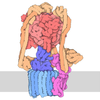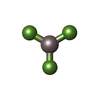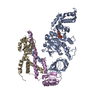[English] 日本語
 Yorodumi
Yorodumi- PDB-6njo: Structure of the assembled ATPase EscN from the enteropathogenic ... -
+ Open data
Open data
- Basic information
Basic information
| Entry | Database: PDB / ID: 6njo | ||||||||||||
|---|---|---|---|---|---|---|---|---|---|---|---|---|---|
| Title | Structure of the assembled ATPase EscN from the enteropathogenic E. coli (EPEC) type III secretion system | ||||||||||||
 Components Components | Translocator EscN | ||||||||||||
 Keywords Keywords | HYDROLASE / ATPase / Type III Secretion System / ADP / hexamer | ||||||||||||
| Function / homology |  Function and homology information Function and homology informationprotein-secreting ATPase / type III protein secretion system complex / protein secretion by the type III secretion system / proton-transporting ATPase activity, rotational mechanism / proton-transporting ATP synthase activity, rotational mechanism / ATP hydrolysis activity / ATP binding / metal ion binding / cytoplasm Similarity search - Function | ||||||||||||
| Biological species |  | ||||||||||||
| Method | ELECTRON MICROSCOPY / single particle reconstruction / cryo EM / Resolution: 3.34 Å | ||||||||||||
 Authors Authors | Majewski, D.D. / Worrall, L.J. / Hong, C. / Atkinson, C.E. / Vuckovic, M. / Watanabe, N. / Yu, Z. / Strynadka, N.C.J. | ||||||||||||
| Funding support |  Canada, Canada,  United States, 3items United States, 3items
| ||||||||||||
 Citation Citation |  Journal: Nat Commun / Year: 2019 Journal: Nat Commun / Year: 2019Title: Cryo-EM structure of the homohexameric T3SS ATPase-central stalk complex reveals rotary ATPase-like asymmetry. Authors: Dorothy D Majewski / Liam J Worrall / Chuan Hong / Claire E Atkinson / Marija Vuckovic / Nobuhiko Watanabe / Zhiheng Yu / Natalie C J Strynadka /   Abstract: Many Gram-negative bacteria, including causative agents of dysentery, plague, and typhoid fever, rely on a type III secretion system - a multi-membrane spanning syringe-like apparatus - for their ...Many Gram-negative bacteria, including causative agents of dysentery, plague, and typhoid fever, rely on a type III secretion system - a multi-membrane spanning syringe-like apparatus - for their pathogenicity. The cytosolic ATPase complex of this injectisome is proposed to play an important role in energizing secretion events and substrate recognition. We present the 3.3 Å resolution cryo-EM structure of the enteropathogenic Escherichia coli ATPase EscN in complex with its central stalk EscO. The structure shows an asymmetric pore with different functional states captured in its six catalytic sites, details directly supporting a rotary catalytic mechanism analogous to that of the heterohexameric F/V-ATPases despite its homohexameric nature. Situated at the C-terminal opening of the EscN pore is one molecule of EscO, with primary interaction mediated through an electrostatic interface. The EscN-EscO structure provides significant atomic insights into how the ATPase contributes to type III secretion, including torque generation and binding of chaperone/substrate complexes. | ||||||||||||
| History |
|
- Structure visualization
Structure visualization
| Movie |
 Movie viewer Movie viewer |
|---|---|
| Structure viewer | Molecule:  Molmil Molmil Jmol/JSmol Jmol/JSmol |
- Downloads & links
Downloads & links
- Download
Download
| PDBx/mmCIF format |  6njo.cif.gz 6njo.cif.gz | 467.2 KB | Display |  PDBx/mmCIF format PDBx/mmCIF format |
|---|---|---|---|---|
| PDB format |  pdb6njo.ent.gz pdb6njo.ent.gz | 380.7 KB | Display |  PDB format PDB format |
| PDBx/mmJSON format |  6njo.json.gz 6njo.json.gz | Tree view |  PDBx/mmJSON format PDBx/mmJSON format | |
| Others |  Other downloads Other downloads |
-Validation report
| Summary document |  6njo_validation.pdf.gz 6njo_validation.pdf.gz | 1.1 MB | Display |  wwPDB validaton report wwPDB validaton report |
|---|---|---|---|---|
| Full document |  6njo_full_validation.pdf.gz 6njo_full_validation.pdf.gz | 1.1 MB | Display | |
| Data in XML |  6njo_validation.xml.gz 6njo_validation.xml.gz | 71 KB | Display | |
| Data in CIF |  6njo_validation.cif.gz 6njo_validation.cif.gz | 106.1 KB | Display | |
| Arichive directory |  https://data.pdbj.org/pub/pdb/validation_reports/nj/6njo https://data.pdbj.org/pub/pdb/validation_reports/nj/6njo ftp://data.pdbj.org/pub/pdb/validation_reports/nj/6njo ftp://data.pdbj.org/pub/pdb/validation_reports/nj/6njo | HTTPS FTP |
-Related structure data
| Related structure data |  9390MC  9391C  6njpC M: map data used to model this data C: citing same article ( |
|---|---|
| Similar structure data |
- Links
Links
- Assembly
Assembly
| Deposited unit | 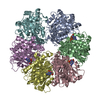
|
|---|---|
| 1 |
|
- Components
Components
| #1: Protein | Mass: 49196.566 Da / Num. of mol.: 6 / Fragment: UNP residues 29-446 Source method: isolated from a genetically manipulated source Source: (gene. exp.)  Strain: E2348/69 / EPEC / Gene: escN, E2348C_3948 / Plasmid: pET28a / Production host:  #2: Chemical | ChemComp-ADP / #3: Chemical | ChemComp-MG / #4: Chemical | ChemComp-AF3 / #5: Water | ChemComp-HOH / | |
|---|
-Experimental details
-Experiment
| Experiment | Method: ELECTRON MICROSCOPY |
|---|---|
| EM experiment | Aggregation state: PARTICLE / 3D reconstruction method: single particle reconstruction |
- Sample preparation
Sample preparation
| Component | Name: Homohexameric complex of ATPase EscN / Type: COMPLEX / Entity ID: #1 / Source: RECOMBINANT |
|---|---|
| Molecular weight | Experimental value: NO |
| Source (natural) | Organism:  |
| Source (recombinant) | Organism:  |
| Buffer solution | pH: 7.5 |
| Specimen | Conc.: 0.34 mg/ml / Embedding applied: NO / Shadowing applied: NO / Staining applied: NO / Vitrification applied: YES |
| Specimen support | Details: unspecified |
| Vitrification | Instrument: FEI VITROBOT MARK IV / Cryogen name: ETHANE / Humidity: 100 % |
- Electron microscopy imaging
Electron microscopy imaging
| Experimental equipment |  Model: Titan Krios / Image courtesy: FEI Company |
|---|---|
| Microscopy | Model: FEI TITAN KRIOS |
| Electron gun | Electron source:  FIELD EMISSION GUN / Accelerating voltage: 300 kV / Illumination mode: FLOOD BEAM FIELD EMISSION GUN / Accelerating voltage: 300 kV / Illumination mode: FLOOD BEAM |
| Electron lens | Mode: BRIGHT FIELD |
| Image recording | Electron dose: 57.67 e/Å2 / Film or detector model: GATAN K2 SUMMIT (4k x 4k) |
- Processing
Processing
| EM software |
| ||||||||||||||||||||||||||||||||||||||||
|---|---|---|---|---|---|---|---|---|---|---|---|---|---|---|---|---|---|---|---|---|---|---|---|---|---|---|---|---|---|---|---|---|---|---|---|---|---|---|---|---|---|
| CTF correction | Type: PHASE FLIPPING AND AMPLITUDE CORRECTION | ||||||||||||||||||||||||||||||||||||||||
| Particle selection | Num. of particles selected: 600000 | ||||||||||||||||||||||||||||||||||||||||
| Symmetry | Point symmetry: C1 (asymmetric) | ||||||||||||||||||||||||||||||||||||||||
| 3D reconstruction | Resolution: 3.34 Å / Resolution method: FSC 0.143 CUT-OFF / Num. of particles: 58000 / Symmetry type: POINT | ||||||||||||||||||||||||||||||||||||||||
| Atomic model building | Protocol: FLEXIBLE FIT / Space: REAL / Details: phenix.real_space_refine | ||||||||||||||||||||||||||||||||||||||||
| Atomic model building | 3D fitting-ID: 1 / Pdb chain-ID: A / Source name: PDB / Type: experimental model
|
 Movie
Movie Controller
Controller


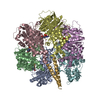


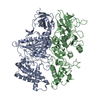
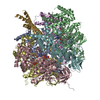
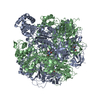
 PDBj
PDBj